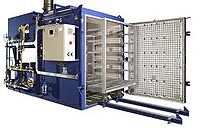Pyrolysis Ovens
Pyrolysis Ovens are used in several industrial applications that involves pyrolysis. Pyrolysis is the thermal decomposition of organic materials in a low-oxygen environment. In the process of traditional burning-out of materials, the binding agents (e.g. varnish, resin, paint and plastic) will combust (due to the high oxygen content), so that the heating of the materials will not be equal. This unequal heating (hot spots) may cause damage to materials (internal cracks), leading to loss of quality and efficiency. When using Pyrolysis, the degree of control is accurate as the parts are heated up in a more controlled way.
Pyrolysis Ovens are capable of decomposing larger amounts of binding agents in comparison with the traditional burnout ovens, since no combustion can take place in a low-oxygen environment, allowing the temperature control to remain optimal.This system not only controls the oven air temperature, but also stator core temperature by controlling the rate of combustion of the varnish/epoxy on the stator. This process provides a precise temperature rate of rise, so as to closely monitor the temperature of the stator undergoing heat stripping, thus assuring you of a quality burn without damaging core laminations.
Videos
